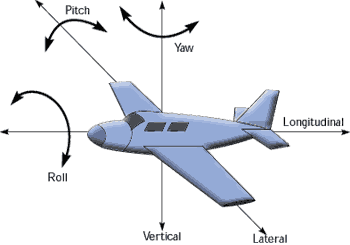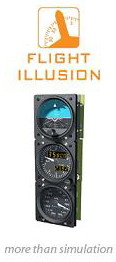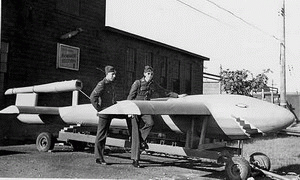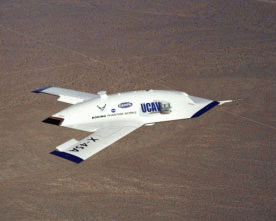! ! WARNING ! !
Above is Zulu Time!!
 |
English |
|||
ATA 22
Auto Flight.
This chapter is THE part that most of you come to know as the automatic pilot, for most of the layman’s this is the system made to give the pilot the chance to eat his lunch or take a nape on long flights while the other flight crew members monitor the plane. Well this is true to some extend, they do take lunch when the auto flight system is engaged, and if they like to rest for a sort period of time during a long flight they do this in shifts so a minimum of human control is guaranteed at all times. But this system is for other reasons installed on aircraft's, flight safety mainly. Economics are also involved, as ever. And comfort to flight crew and passengers.
To be able to explain what this system does, you need to now some basics about airplanes.
PITCH ROLL AND YAW.
An airplane has three axes of movement being; pitch, roll and yaw. For each of dies movements there is a specific computer needed to be able to control them. In most cases these “computers” are called channels.So for example:


1.pitch-channel, nose up or down to be able to change flight level.
2.roll-channel, left wing up and right wing down or visa versa to be able to turn left or right.
3.yaw-channel, tail left or right to be able to bank left or right.INFO: the deference between turning and banking is a matter of “speed”, the roll movement is created by use of the ailerons at the wings, while the yaw movement is done by using the rudder at the tail. Now, when only the ailerons move the aircraft to turn to the left it will make a large turn, if you would make the same turn with both the ailerons and rudder the aircraft will make a sort “U” turn depending upon the amount of rudder you’ve given. So to resume, the rudder will push the tail left or right while the ailerons pushes the wings up/down for a right turn and down/up for a left turn.
THRUST.
But to stay in flight an aircraft needs thrust of course, coming from one, two or more engines, during auto flight the thrust is also automatically controlled in relation to the movements being made by the plane at any given time. For instance: if the aircraft climbs during flight it will need more thrust to maintain the same speed. The system will command the engine(s) to deliver more thrust. When the plane comes to the flight level selected by the flight crew it will level-off and decrease the throttles again.YAW DAMPER AND PITCH TRIM.
These systems are only used on large airplanes. (Boeing, Airbus, etc.)The Yaw Damper system is design to aid in the stability of the airplane, at any given time, both manually as automatic flown. And so to make the automatic system smoother in his movements. So the passengers don’t get sick to quick ! Without this system the autopilot would move the plane like the first robot did! Of course this system controls only the yaw movements.
The Pitch Trim system will control the pitch-up attitude or nose-up and this in relation to the speed and other factors.
Now you know WHAT the systems does, and WHY, but not HOW. Well, within this system generally speaking you’ll find basic parts.
1.) The "channel or computer", controlling his part within the system, and in the system you’ll find several computers all talking to one another. All computers are in pairs one for the pilot side and one for the first officer side. They call this redundancy. In case one system channel fauls, the other will take his job over.2.) The actuator will move the flight controls or the engine controls in the direction and amount the control system tells it to go. These actuators are hydraulically or electrical operated and are, in case of hydraulic actuator, normally fed by all hydraulic systems aboard the plane, in most cases there are several systems. And so all systems feed these actuator to make them fail-safe. Call it redundancy so if one of the hydraulic systems fail to operated the actuators still have enough operating pressure.
3.) The indication gives the flight crew a representation of what the plane’s attitude is at all times, the position of the flight controls, amount of thrust supplied, navigation, and so on, are all inter connected with each other to be able to control the plane and his course its supposed to fly. Also it gives the flight crew a tool to check if the auto pilot system is doing his work, and in case of failure to determine in a quick fashion what's exactly wrong. To be able to bypass the failure or even rectify the flaw during flight, if possible.
Within this system there are a lot of micro switches and other gismos, but also a testing circuit being a helpful tool for the technicians in case of a flaw in this brilliant system. This system is not only made to operated aircraft's in a safe way, but also to improve comfort for both flight crew and passengers, and to be able to operated airplanes in a economical way. In other words, to be able to fly the same distance with less fuel burned. A direct result of this is to be cheaper at the ticketing desk at the airport. For example: some customers get a price surplus notice on there booked ticket due to fuel prices rising. Just to state that fuel consumption is one of the main reasons of price settings used for tickets sold by operators. So reducing the cost to the minimum, the flight crews are tolled to use the auto flight system to the maximum of its capacity.
Even take-off and landings are present-days automated to assist in the constant drive to uphold and improve flight safety and fuel consummation, especially landings for zero visibility operations like fog. Auto take-off is technically possible but not used, or not very much.
The newer aircraft even have the ability to taxi from the spot to the runway or visa versa, so in that case the complete flight could be automatic performed from parking spot at let’s say Newark, to a parking spot at Charle De Gaulle. But this system together with the take-off system is not much used.
In fact the military use dies systems in the, what they call:" the weapons of the next century", being the Unmanned Aerial Vehicle or UAV's.
Dies new version of the V1, used during World War 2 by the Germans, are now used by the Americans and the rest of the world! The difference between these two are remarkable!
Article last modified on 10/06/2015

|

|
|
(c) 2004 www.simbuilder.be Created by See3D.be |
||


